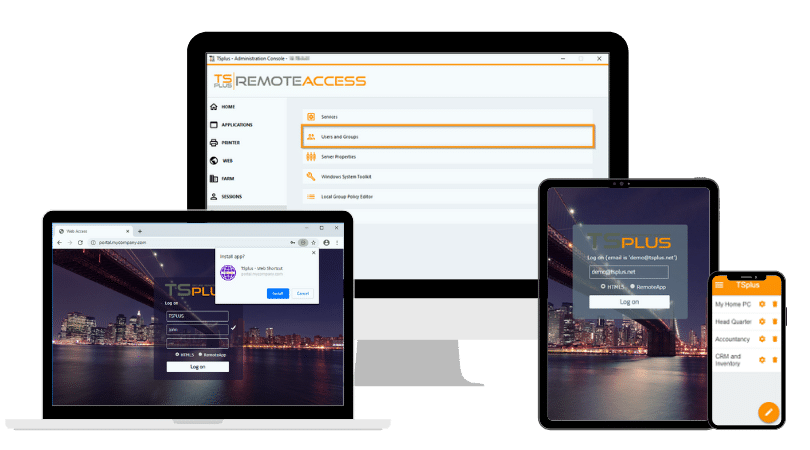Introduction
With the shift to hybrid work and increased dependency on remote desktop access, ensuring secure remote sessions is paramount. Remote Desktop Protocol (RDP), while convenient, is also a frequent target for cyberattacks. One of the basic protections of your RDP is NLA. Learn about it, how to enable and most importantly how RDP Network Level Authentication (NLA) enhances
remote access
security.
What is Network Level Authentication?
This section will cover basics:
-
Definition of NLA
-
Difference between Traditional RDP and NLA
Definition of NLA
Network Level Authentication (NLA) is a security enhancement for Remote Desktop Services (RDS). It requires users to authenticate themselves before a remote desktop session is created. Traditional RDP allowed the login screen to load before verifying credentials, therefore exposing the server to brute-force attempts. NLA shifts that validation to the very beginning of the session negotiation process.
Difference between Traditional RDP and NLA
|
Feature
|
Bare RDP, without NLA
|
RDP with NLA Enabled
|
|
Authentication Takes Place
|
After session starts
|
Before session starts
|
|
Server Exposure
|
High (Total)
|
Minimal
|
|
Protection Against Brute Force
|
Limited
|
Strong
|
|
SSO Support
|
No
|
Yes
|
How NLA Works
NLA leverages secure protocols and layered validation to protect your server by changing
when
and
how
authentication occurs. Here is the breakdown of the connection process:
-
Initial Request:
The user initiates a connection via the RDP client.
-
Credential Validation:
Before the session begins, the client uses Credential Security Support Provider (CredSSP) to securely pass credentials.
-
Secure Session Establishment:
If credentials are valid, a secure session is created using TLS or SSL, encrypting all communication.
-
Desktop Session Start:
Only after the user is authenticated does the full RDP session start.
What Difference Has NLA Made Here?
Let us break down what the activation of NLA changes to RDP connection requests.
Unsafe Connexions Begin Without NLA:
-
The RDP server loads the login screen
before
checking credentials.
-
This means
anyone
can open a session window, even attackers.
-
The server uses its resources to display the login interface, even for unauthorized users.
Secure Connexions Start With NLA:
With NLA, step 2 above became critical.
-
Before a session (and before the graphical login screen appears), the RDP client must provide valid credentials via
CredSSP
.
-
If the credentials are invalid, the connection is refused immediately, so the server never loads the session interface.
Consequently, NLA effectively "shifts" the authentication step to the
network layer
(hence the name),
before
RDP initializes the remote desktop environment.
As noted in the
Microsoft authentication documentation
, NLA uses Windows Security Support Provider Interface (SSPI) to integrate seamlessly with domain authentication.
Why Network Level Authentication Matters?
As
Wikipedia's RDP entry
confirms, RDP has been a vector in several high-profile ransomware attacks. NLA is vital for protecting remote desktop environments from various security threats. It prevents unauthorized users from even initiating a remote session, thus mitigating risks such as brute force attacks, denial-of-service attacks and remote code execution.
Here is a quick summary of RDP security risks without NLA:
-
Brute force attacks on exposed login screens
-
Denial-of-Service (DoS) from unauthenticated connection floods
-
Remote Code Execution (RCE) vulnerabilities
-
Credential stuffing using leaked usernames/passwords
Enabling NLA is a simple yet effective way to minimize these threats.
What Are the Benefits of Enabling NLA?
Network Level Authentication offers both security and performance advantages. Here is what you gain:
-
Stronger Authentication
-
Reduced Attack Surface
-
Brute Force Defense
-
SSO Compatibility
-
Better Server Performance
-
Compliance Ready
Stronger Authentication
Network Level Authentication requires users to verify their identity before any remote desktop session begins. This front-line validation is done using secure protocols like CredSSP and TLS, ensuring that only authorized users even reach the login prompt. By enforcing this early step, NLA drastically reduces the risk of intrusion through stolen or guessed credentials.
What is CredSSP?
According to
Microsoft
, the Credential Security Support Provider protocol (CredSSP) is a Security Support Provider that lets an application delegate the user's credentials from the client to the target server for remote authentication.
This type of early verification is aligned with cybersecurity best practices recommended by organizations like Microsoft and NIST, especially in environments where sensitive data or infrastructure is involved.
Reduced Attack Surface
Without NLA, the RDP login interface is publicly accessible, making it an easy target for automated scans and exploit tools. When NLA is enabled, that interface is hidden behind the authentication layer, significantly reducing the visibility of your RDP server on the network or internet.
This “invisible-by-default” behavior aligns with the principle of least exposure, which is crucial in defending against zero-day vulnerabilities or credential stuffing attacks.
Brute Force Defense
Brute-force attacks work by repeatedly guessing username and password combinations. If RDP is exposed without NLA, attackers can keep trying indefinitely, using tools to automate thousands of login attempts. NLA blocks this by requiring valid credentials up-front so unauthenticated sessions are never allowed to progress.
This not only neutralizes a common attack method but also helps prevent account lockouts or excessive load on authentication systems.
SSO Compatibility
NLA supports NT Single Sign-On (SSO) in Active Directory environments. SSO, according to
Amazon
, allows users to log in to multiple applications and websites with one-time user authentication. It streamlines workflows and reduces friction for end users.
For IT administrators, SSO integration simplifies identity management and reduces help desk tickets related to forgotten passwords or repeated logins, especially in enterprise environments with strict access policies.
Better Server Performance
Without NLA, each connection attempt (even from an unauthenticated user) can load the graphical login interface, consuming system memory, CPU and bandwidth. NLA eliminates this overhead by requiring valid credentials before initializing the session.
As a result, servers run more efficiently, sessions load faster, and legitimate users experience better responsiveness, especially in environments with many concurrent RDP connections.
Compliance Ready
Modern compliance frameworks (such as GDPR, HIPAA, ISO 27001, …) require secure user authentication and controlled access to sensitive systems. NLA helps meet these requirements by enforcing early-stage credential validation and minimizing exposure to threats.
By implementing NLA, organizations demonstrate a proactive approach to access control, data protection and audit-readiness, which can be crucial during regulatory reviews or security audits.
How to Enable Network Level Authentication?
Enabling NLA is a straightforward process that can be accomplished through various methods. Here, we outline the steps to enable NLA via Remote Desktop settings and the System and Security settings.
-
Windows Settings
-
Control Panel
-
Group Policy Editor
Method 1: Enabling NLA via Windows Settings
1. Press Win + I to open Settings
2. Go to System > Remote Desktop
3. Toggle Enable Remote Desktop
4. Click Advanced Settings
5. Check "Require computers to use Network Level Authentication"
Method 2: Enabling NLA via Control Panel
1. Open Control Panel > System and Security > System
2. Click Allow Remote Access
3. Under the Remote tab, check:
“Allow remote connections only from computers running NLA (recommended)”
Method 3: Group Policy Editor
1. Press Win + R, type gpedit.msc
2. Navigate to:
Computer Configuration > Admin Templates > Windows Components > Remote Desktop Services > RDSH > Security
3. Set "Require user authentication for remote connections by using NLA" to Enabled
How to Disable Network Level Authentication?
While disabling NLA is generally not recommended due to the security risks, there might be specific scenarios where it is necessary: legacy systems without CredSSP support, troubleshooting RDP failures and third-party client incompatibilities. Here are methods to disable NLA:
-
System Properties
-
Registry Editor
-
Group Policy Editor
Method 1: Using System Properties
Disabling NLA through System Properties is a direct method that can be done via the Windows interface.
Step-by-Step Guide in Syst Prop
-
Open Run Dialog: Press
Win + R
, type
sysdm.cpl
, and hit Enter.
-
Access Remote Settings: In the "System Properties" window, go to the "Remote" tab.
-
Disable NLA: Uncheck the option "Allow connections only from computers running Remote Desktop with Network Level Authentication (recommended)."
Risks and Considerations
Increased Vulnerability:
Disabling NLA removes the pre-session authentication, exposing the network to potential unauthorized access and various
cyber threats
.
Recommendation:
It is advised to disable NLA only when absolutely necessary and to implement additional security measures to compensate for the reduced protection.
Method 2: Using Registry Editor
Disable NLA through the Registry Editor, to provide a more advanced and manual approach.
Step-by-Step Guide in RegEdit
-
Open Registry Editor: Press
Win + R
, type
regedit
, and hit Enter.
-
Navigate to Key: Go to HKEY_LOCAL_MACHINE\SYSTEM\CurrentControlSet\Control\Terminal Server\WinStations\RDP-Tcp`.
-
Modify Values: Change the values of "Security Layer" and "User Authentication" to
0
to disable NLA.
-
Restart System: Reboot your system for the changes to take effect.
Risks and Considerations
Manual Configuration:
Editing the registry requires careful attention, as incorrect changes can lead to system instability or security vulnerabilities.
Back-up:
Always back up the registry before making changes to ensure that you can restore the system to its previous state if needed.
Method 3: Using Group Policy Editor
For environments managed via Group Policy, disabling NLA can be controlled centrally through the Group Policy Editor.
Step-by-Step Guide in GPEdit
1. Open Group Policy Editor: Press
Win + R
, type
gpedit.msc
, and hit Enter.
2. Navigate to Security Settings: Go to Computer Configuration -> Administrative Templates -> Windows Components -> Remote Desktop Services -> Remote Desktop Session Host -> Security.
3. Disable NLA: Find the policy named "Require user authentication for remote connections by using Network Level Authentication" and set it to "Disabled."
Risks and Considerations
Centralized Management: Disabling NLA through Group Policy affects all managed systems, potentially increasing the security risk across the network.
Policy Implications: Ensure that disabling NLA aligns with organizational security policies and that alternative security measures are in place.
How to Enhance Your Security with TSplus
TSplus fully supports NLA
(Network Level Authentication) to secure remote desktop access from the start of each session. It enhances native RDP security with advanced features such as Two-Factor Authentication (2FA), IP filtering, brute-force protection and application access control, creating a robust, multi-layered defense system.
With
TSplus
, administrators gain centralized control through a simple web console, ensuring secure, efficient, and scalable remote access. It is an ideal solution for organizations seeking to go beyond standard RDP security without added complexity or licensing costs.
Conclusion
Network Level Authentication is a proven way to secure RDP connections for
remote access
by enforcing pre-session user verification. In today’s remote-first landscape, enabling NLA should be a default step for all organizations using RDP. When combined with extended features offered by tools like TSplus, it provides a reliable foundation for secure, efficient application publication.
TSplus Remote Access Free Trial
Ultimate Citrix/RDS alternative for desktop/app access.Secure, cost-effective,on-permise/cloud









)



)
)
)
)



